Park roses: description, planting and further care
Despite its aristocratic beauty, park roses are quite hardy to environmental conditions and can be grown even by inexperienced gardeners by amateurs. They do not require complicated maintenance, they are easy to propagate, and the variety of varieties allows you to choose exactly the flower that best decorates the landscape. Consider a detailed description of park roses and a list of their varieties, as well as the features of their planting, cultivation and propagation, caring for bushes and possible problems with plants.
Description and features of park roses
Park roses are a group that combines three main types of plants: decorative rose hips, modern hybrids and ancient roses. A common feature of all plants is their appearance in the form of a bush and the possibility of wintering on the street even at low temperatures.




















To understand in detail what it is - park roses, consider their main characteristics:
- The height of different varieties of plants can be from 1.5 m to 2.5 m.
- The root system is powerful, its length can be up to 2 m.
- The branches of the plant are covered with many sharp spikes.
- The foliage of the plant is thick, green. The leaves are small, oval in shape.
- The flowering is plentiful, lasts 3-4 weeks and is repeated every year from May to the end of June. Some varieties re-bloom in August.
- Flowers consist of a large number of petals, tightly pressed to each other.
- The color of roses varies from white to bright purple. There are varieties with yellow and orange flowers.
- Flowers have a delicate and pleasant aroma.
- In place of dried buds, fruits are formed. Depending on the variety, they are round or oval, have a different color. In some varieties, the fruits are edible.
The most beautiful varieties include park roses with the following names:
- Remi Martin (France);

- Golden Celebration (Golden Celebration), England;

- Martin Frobisher (Canada);

- Cardinal Richelieu (Cardinal de Richelieu), France;

- John Franklin, Canada

- Prairie Joy, Canada;

- Benjamin Britten, England;

- Henry Kelsey, Canada
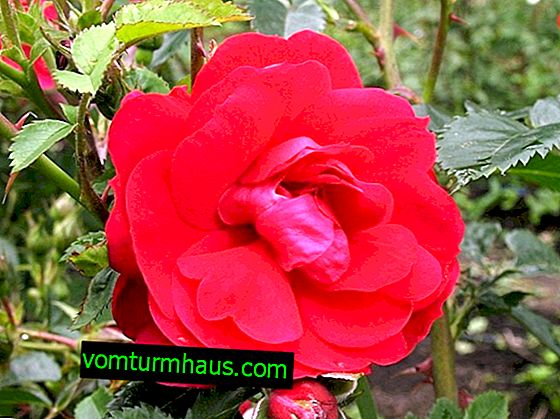
- Wrinkled rose (Rosa rugosa), England;
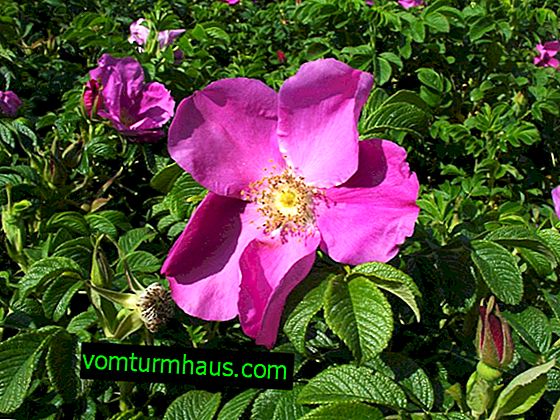
- Alexander MacKenzie, Canada

- Centifolia (Rosa centifolia), France;
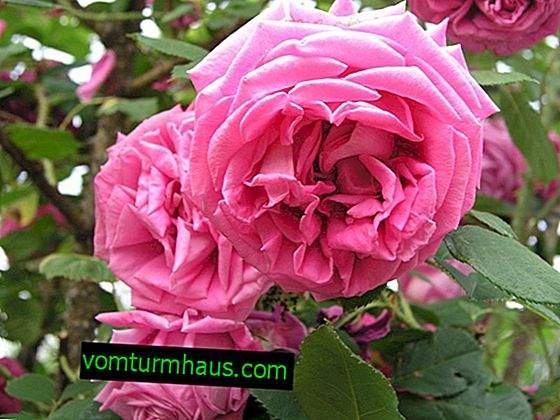
- Moden Blush, Canada;

- Winchester Cathedral (Winchester Cathedral), England.
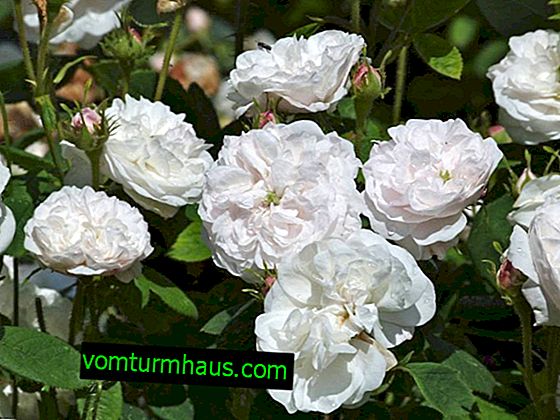
Classification of Park Roses
There are many varieties of park roses. Some were known several centuries ago, while others were recently bred.
But according to the generally accepted classification, all these varieties can be divided into two types:
- once blooming - blooming is observed once a year in the time interval from May to June;
- re-blooming - can bloom in June and re-blooming in August, were artificially bred by breeders.
Important! Once blooming park roses are more resistant to cold weather and require the preservation of last year's shoots for the next flowering.
Re-flowering varieties are divided into three groups:
- frost-resistant rugoses (hybrids) - can be found in winter without shelter;
- cold-resistant Canadian roses - winter without shelter, if the winter is not too harsh, but in severe frost they need protection;
- varieties with low resistance to frost - always require shelter in the cold season.
Planting flowers
Park roses can be planted individually or in groups. And you can form whole hedges from these flowers. Planting plants is not difficult, but requires some additional work and the correct sequence of actions.
Optimal timing
These flowers grow on the street, so they need to be planted in the warm season. You can start planting bushes in May and carry it out until mid-autumn.

For good rooting and growth, it is better to plant plants in late September or even early October. In this case, they will have time to grow roots and will be stronger and more developed than flowers planted in the spring.
Preparatory work
So that the bushes are better taken and rooted when planting on the site, you need to prepare the soil and the seedlings themselves.
Before planting, it is recommended to carry out several mandatory actions:
- dig up the soil in the area to a depth of about 60 cm a month before planting;
- introduce mineral and organic fertilizers into the soil to enrich it with all the necessary useful substances;
- if it is impossible to immediately plant the seedlings, then their roots need to be lowered into water or wrapped with a damp cloth to prevent them from drying out;
- 2 weeks before planting, dig holes in the soil with a diameter of 90 cm and a depth of about 70 cm. The recesses should be wide so that the spreading roots of seedlings fit into them.
Gardeners also grow rose varieties such as:
Landing technology
After the plot and seedlings are prepared, you can proceed directly to the planting of flowers. This is a simple process, but requires some rules to be followed.
Step-by-step instructions for planting park roses are presented below:
- The distance between adjacent bushes in the same row should be 1–1.5 m, so that adult plants do not grow closely together.
- The distance between the rows of bushes should be at least 3 m.
- Mix the earth obtained by digging holes with manure.
- Pour a little of this mixture into each well and pour it well with water.
- Trim the wrinkled and spoiled roots of seedlings with secateurs. Trim the tips of the ground part of the shoots, leaving three eyes on each of them.
- In the pit place the roots of the seedling, spread them and sprinkle with soil. The earth around the plants is well tamped.
- Water the plants and spud them to a height of 20–25 cm.
- If planting is carried out in autumn, then mulch the soil around the bushes. As mulch, you can use peat or chopped straw.
Did you know? The oldest rose bush grows in the German town of Hildesheim near the cathedral. The plant is about 1000 years old.
If the bushes of plants should form a hedge, then they are planted closer to each other. The distance between the rows is 50–70 cm, and between adjacent plants in the same row - up to 1 m.
Features of cultivation and care
Park rose does not require complex and scrupulous care. It is able to withstand low air temperatures and is well pollinated by insects, and flower reproduction is not difficult.

The most careful care is required by young rose bushes that have not reached the age of 3 years. They need strict adherence to the recommendations described below and require regular cultivation of the earth. Let us consider in more detail the general recommendations for the care and cultivation of all park roses.
Location and optimal conditions
Plants can be grown under various conditions, but for lush and regular flowering, you need to take into account the peculiarities of the location of the plot with flowers.
Important! If the soil for roses is sandy, add peat and compost to it, and if clay - sand, peat and compost.
Here are some guidelines for choosing a landing site:
- plants need good lighting, so it’s better to plant them in open areas. Roses can grow in partial shade, but in this case the flowering will not be so plentiful;
- You cannot plant park roses near trees. The roots of the bushes will not have enough nutrients for normal growth, as the trees will pick up most of the trace elements from the ground;
- the soil should be of medium acidity;
- the site with plants should be in a place protected from the wind, the flowers do not grow well and bloom in the draft;
- it is impossible for the groundwater to be closer than 1 m from the surface of the earth in the area with flowers - the roots of the bushes in this case will be waterlogged and rot;
- It is not recommended to plant park roses near other fragrant plants, so as not to mix aromas.

Watering and feeding
Plants tolerate drought better than too moist soil. But for normal development, watering bushes of park roses in spring and summer should be plentiful. During this period, plants spend a lot of energy on growth and flowering.
Did you know? The rose of the Chameleon variety, bred in Japan, changes the color of the petals throughout the day from bright red to white.
Consider the main watering recommendations:
- watering should be carried out in the early morning or evening, when the sun is already declining;
- if the weather is dry, you need to water the park roses in the summer 2-3 times a week;
- on one bush you need to spend 1-2 buckets of water;
- during watering, it is necessary to achieve deep soil moisture, surface watering will not provide the roots of the flowers with the necessary amount of moisture;
- water the plants under the root so that water does not fall on the leaves and flowers;
- by the beginning of autumn, park roses are preparing for the winter dormancy, so in September you need to stop watering them.
Plants consume from the soil a large amount of the nutrients they need for normal growth and abundant flowering. Therefore, the soil near the bushes must be constantly enriched with the necessary substances with the help of fertilizers. Feeding should be done throughout the entire period of growth and flowering.

The basic fertilizer application rules for park roses are presented below:
- for good growth and growth of green mass in the spring, plants are fed with manure and fertilizers containing iron, boron and magnesium;
- to strengthen the roots at the end of summer fertilizers are added containing calcium, potassium and phosphorus;
- in early autumn, bushes are watered under the root with a liquid solution of superphosphate and potassium monophosphate;
- To enrich the soil with micronutrients in October, rotted compost is introduced under the plants.
You will be interested to know which varieties of roses are the most fragrant and fragrant, and which are the smallest.
Breeding
Park roses are easy to reproduce. This procedure is best done in the spring, but some preparatory actions need to be carried out in the fall. Consider the methods of reproduction of park roses and their brief description.
- Layering. The lateral stems of the plant are tilted to the ground and fixed in this position. Top tilted shoots sprinkled with earth for rooting. In this position, the branches are a whole year - until next spring. Then rooted branches are carefully separated from the mother bush and transplanted to a permanent place.
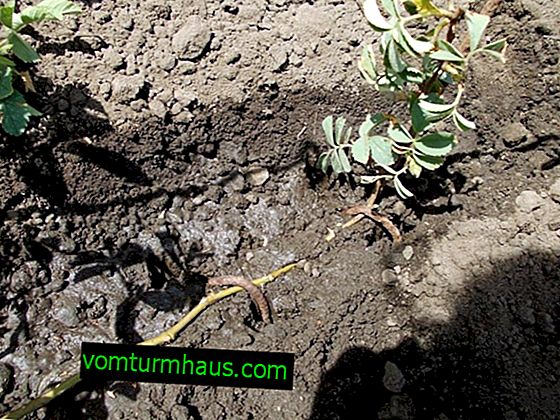
- Overgrown. Bushes of park roses constantly form young shoots. When the shoot reaches the age of 1 year, it is separated from the parent bush and planted separately. At the same time, its stem must be shortened by one third.

- By dividing the bush. The procedure can be performed both in spring and autumn. Using a pruner, a bush of park roses is divided into two parts. Each of them must have roots and at least one stem. One of the parts of the bush is left in the same area, and the second is transplanted to another place.

- Cuttings. For this method of reproduction, green cuttings or lignified are suitable. Green cuttings need to be cut from the bush at the beginning of the flowering period, and lignified - in the fall. After cutting, they are buried in the sand for rooting, and in the spring they are transplanted to a permanent place.
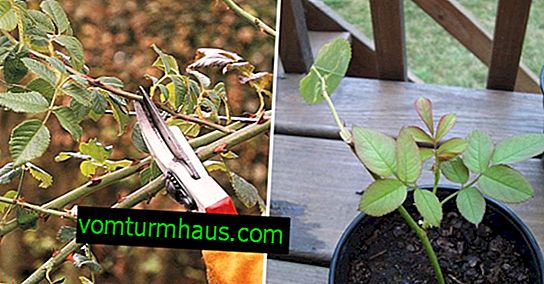
Pruning and sheltering roses for the winter
In order for the bushes to maintain an attractive and flowering appearance, it is necessary to carry out their pruning pruning annually. It will not only help give the bush a beautiful shape, but will also increase the number of buds during the flowering period. It is best to carry out this procedure in April.
Important! For the first time, pruning can only be done 2 years after planting the bushes.
Consider the basic rules of pruning a plant:
- remove damaged and dried branches as necessary;
- it is on lignified branches that flowers are formed, so the number of such branches should be maximum;
- shoots need to be cut so that at least 6 buds remain on them;
- if you want to rejuvenate the bush of park roses, then its old stems need to be cut off near the ground itself. In this case, they begin to grow rapidly;
- so that pruning does not harm the plant, all places of the cut must be carefully treated with oil paint.
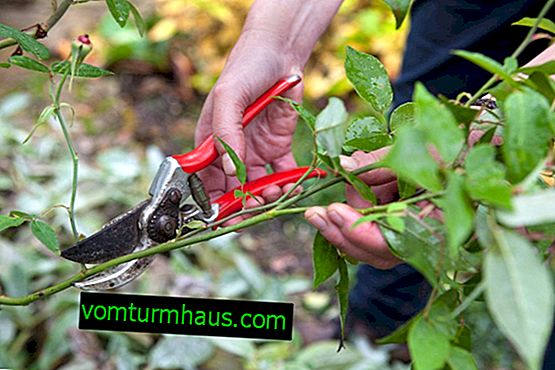
Some varieties of park roses can be grown even in regions with harsh climates. They can easily overwinter under light shelter and not freeze. But young bushes are more susceptible to low temperatures, so you need to carefully cover them for the winter.
The basic rules for preparing park roses for the winter are as follows:
- bushes need to be sprinkled with earth to a height of about 25 cm;
- the branches need to be slightly bent and wrapped with thick craft paper to protect them from low temperatures, wind and too bright spring sun;
- when the air temperature drops below –8 ° С, the bushes are covered with spruce branches (coniferous branches);
- if the air temperature is not too low (about 0 ° C), then in the shelter for the bushes you need to make an outlet so that mold does not form on them.
Learn more about when and how to prune roses, and what are the rules for pruning roses for the winter.
Prevention and control of pests and diseases
Park roses are grown outdoors, so you need to pay attention to the prevention of possible diseases and pests.
Most often, when growing plants, such problems arise:
- Powdery Mildew During the disease, a white coating forms on the lower surface of the leaves. To prevent this problem is easier than curing a diseased bush, so park roses are treated with iron sulfate before the start of the growing season. In summer, plants are sprayed with an aqueous solution of lime with the addition of sulfur and salt.

- Garden Khrushchev. Both adult insects and their larvae are dangerous. Pests eat leaves of the bush, which leads to its death. To prevent this, you need to regularly inspect park roses and, when bugs appear, collect them from plants.

- Raspberry weevil. Lays eggs in flower buds, from which gluttonous larvae hatch, eating everything in its path. Insects need to be removed from the bush when they first appear.

- Lack of flowering. The cause of the problem may be a lack of sunlight or fertilizer. In the first case, the bush needs to be transplanted to a more illuminated place, and in the second - feeding regularly (manure, compost, mineral fertilizer complexes). Trimming the bush also helps to stimulate abundant flowering.
- Thrips. May appear with excessive watering of bushes of park roses and their placement in the shade. To prevent the occurrence of a pest, the bushes are treated with an aqueous solution of chamomile or nettle infusion.

Use in landscape design
Park roses are used for vertical landscaping, and a variety of colors allows you to create colorful floral arrangements with a unique delicate aroma. Often, bushes of park roses are planted close to each other in a checkerboard pattern so that they form a hedge.
Did you know? The largest rose in the world - Lady Banks (Lady Banks), has a trunk circumference of 3.7 m and grows in a cemetery in Tombston (Arizona, USA).
In small areas, single-planted bushes look very nice. With the help of pruning, they can be given a lush and neat shape, and around the plants you can make a regular green lawn.
Park roses will decorate any site and will not require much time and effort to care. In order for the bushes to annually please with abundant flowering and lush green mass, it is enough to follow the simple recommendations for growing described in this article.

























